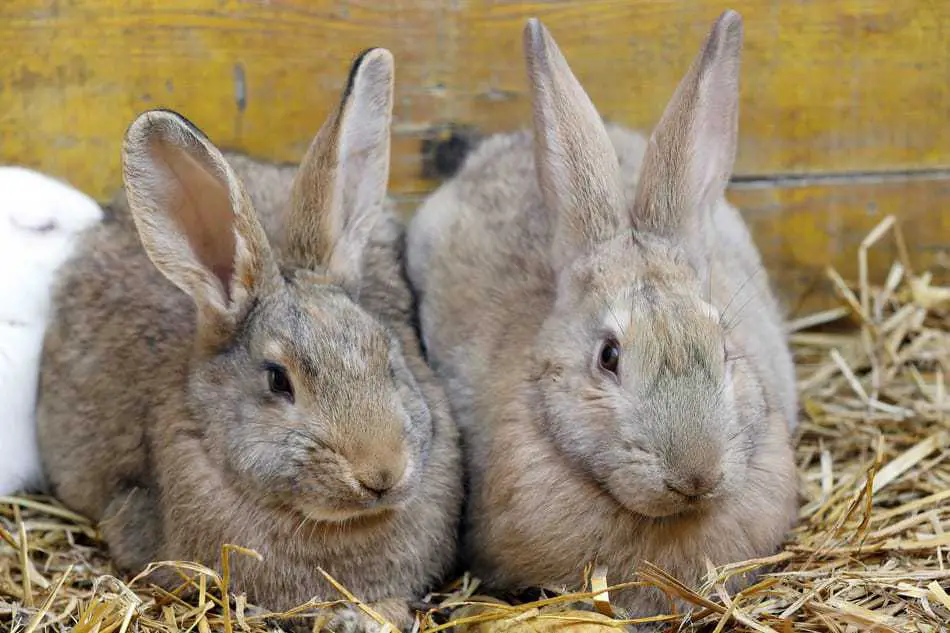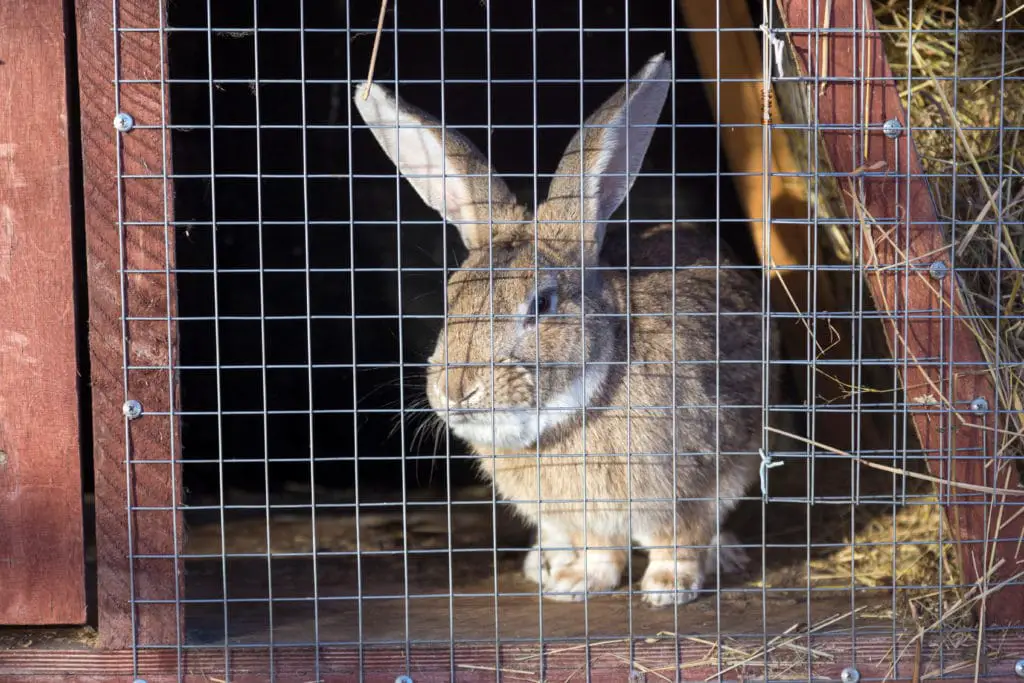
Rabbits are social animals who thrive in each other’s company. Rabbits almost always need a bonded companion, which can help them stay calm, happy, and healthy. Introducing rabbits to each other can be a complicated process though, especially if one rabbit is an adult and one is a baby.
It’s difficult for adult rabbits and baby rabbits to form lasting bonds because babies aren’t fully mature and their scent changes with time. However, owners can successfully introduce them by letting the rabbits meet from a distance and monitoring all face-to-face interactions in the beginning.
Most adult rabbits don’t have strong parental instincts that will help them bond with babies. However, they do have behaviors and habits that remain constant throughout the various stages of their lives. With patience, encouragement, and a bit of luck, owners can take advantage of these behaviors to encourage good relationships between a certain pair of rabbits.
Step-by-Step Bonding Process
- Pick Your Rabbit Pairing
Rabbits are social and don’t live alone in the wild. Domesticated rabbits follow many of the same guidelines! Wild rabbits usually live in groups of 10-15, with one dominant male in the group. Don’t worry if you don’t have the time and space to care for that many rabbits though! As long as they have at least one bonded friend, your rabbit will be happy.
Different sex combinations have different challenges and success rates. Siblings from the same litter will usually be already bonded and they have a high likelihood of getting along.
One male and one female will generally get along best because the male will be dominant and the female will be submissive. They will also feel less need to compete with each other. If you’re trying to bond an adult rabbit with a baby, the best chance you have will probably be with a male and female pair.
Two males or two females can be successfully bonded, but that can be more complicated. Two males will often end up fighting over territory and will be more aggressive as they try to assert dominance. Two females may get along more easily, but they can run into the same problems, especially if they haven’t been spayed.
DID YOU KNOW? Some rabbits are easier to take care of than others. This list of the 6 easiest rabbit breeds to take care of will help give you clarity when choosing a new companion for your rabbit!
- Spay and Neuter
This is one of the most important steps to any rabbit bonding process! You probably don’t want to be dealing with constant litters of baby rabbits, but there are multiple other reasons to spay/neuter your rabbits before you introduce them.

First, and most obviously, you want your rabbits to avoid pregnancy if you’re not ready for it. Rabbits reproduce quickly and quite often in the wild. Each litter contains several baby rabbits, which will need to be cared for by the owner, or given to new homes. This is a lot of hassle that can be easily avoided by a quick trip to the vet!
Second, the sex drive of rabbits can cause complications when you’re trying to introduce them to each other. The hormones of both males and females can make them territorial and aggressive, and that will get in the way of bonding.
Finally, rabbits who have been spayed or neutered are safer from a variety of health problems. Rabbits can develop cancer in their reproductive organs, which can be painful for them and expensive for owners to deal with.
CAN A NEUTERED RABBIT STILL SPRAY?
Great question! They can still spray for a certain time period after neutering, but after that period, spraying should decrease. Click on the link above to read my article with a more descriptive answer to this question!
Spaying and neutering your rabbits really is the best choice for everyone involved! Your rabbits will be calmer and healthier, and will often live longer as a result. Female rabbits can be treated when they are 4-6 months old, while males can be neutered at 8-12 weeks.
Make sure to give them a recovery period, since females are still fertile up to two weeks after their surgery. Six weeks is the recommended amount of time, since this gives the rabbits enough time to heal from the surgery, and the hormones enough time to dissipate.
- Introduce Rabbits in Separate Cages
Rabbits are territorial, and like to claim a space as “their own”. This is especially true of adult rabbits that you might have had for a longer period of time. They’ll be comfortable in their own space and probably won’t enjoy sharing it with a newcomer at first.
Bonding rabbits need to be done gradually to avoid stress and aggression. Start by giving each rabbit their own individual territory so they can feel comfortable when they meet each other.
If possible, give each rabbit their own small cage that can be used when they first meet. Give them food, water, comfortable padding, and enough space to see and smell the outside world.
Place the cages close to each other, but just far enough apart that the rabbits can’t touch each other. Make sure they can see and smell each other easily. After a few caged meetings, try feeding them at the same time so they can get used to eating together.
Since babies are still maturing and will have more energy, it’s advisable to keep them at this distanced cage stage until the baby is old enough to be spayed/neutered. This will help the adult get used to the idea of this newcomer, and will keep both of them safe and comfortable.
Sniffing through the bars, chirping, honking, and lying down are good signs that your rabbits are beginning to get used to each other.
- Introduce Face-to-Face
Once your rabbits have become fairly comfortable with each other’s presence, it’s time to try the next step!
The rabbits need to meet face to face in neutral territory. If one of them feels like their space is being invaded, that will make it much harder for them to get along. Take them into a new room they haven’t spent much time in, such as a bathroom.
Clear items off the floor and make sure the area is clean. Provide a couple of boxes or toy tunnels that the rabbits can retreat to if they’re nervous (but make sure there are multiple exits so that one rabbit can’t trap the other inside).
Place them on opposite sides of the room so they have time to approach at their own pace. In an unfamiliar place, they might want a minute to get familiar with their surroundings before doing anything else.

Watch them closely the whole time. Sniffing, circling, nuzzling, grooming, nipping, and mounting are all normal behaviors at this stage. They’re getting used to each other and may try to establish dominance. Little nips are normal but watch for signs of growing aggression. Have a spray bottle full of water on hand to break up any fights.
After 10-20 minutes, put the rabbits back in their separate cages. Repeat this process at least once per day, increasing the time they spend together if there aren’t any problems. You can introduce toys and snacks to their meetings to help them play and eat together.
It’s a good sign if your rabbits lie down next to each other and groom or nuzzle each other. This is evidence that they are bonding well and are ready to try the next step.
- Place Both Rabbits in New Enclosure
Once your rabbits are comfortable with each other, you can try putting them in the same living space.
Prepare an enclosure that has enough space for both rabbits. Clean it out thoroughly beforehand and try to make sure it doesn’t have too much of either rabbit’s scent. This will help both of them feel more at ease as they claim the space as their own.
When preparing their area, you’ll want to consider the litter box. If you follow all the steps of introductions as outlined in this article, there is a less likely chance of problems occurring. However, Can Two Rabbits Share a Litter Box? An Owner’s Guide is an article I wrote that will help you with dilemmas you may run into (such as age pairing in this instance).
Make the space as comfortable and pleasant as possible! Give them plenty of food and water, toys, places to hide and sleep, and maybe a few of their favorite snacks to make it a good experience. This checklist of must-haves comes with my list of personal recommendations and will allow you to feel confident that your rabbit has everything he or she needs.

Continue to monitor the rabbits in the new enclosure. You can expect a few little scuffles as they get used to the new area and each other, but any real fights should be broken up immediately. Rabbits commonly fight because of stress, hormones, or changes to their environment. Check out my article Five Reasons Pet Rabbits Fight and How to Stop Them to find out more on this topic.
Eventually, the rabbits will get used to sharing the space and can start enjoying each other’s company! Once your rabbits have become bonded, try to keep them together at all times. They love their new companion and it can cause stress and behavior changes if they’re separated.
If your rabbits fight excessively at any point of this introduction process, you may need to go back to step one and try again. Don’t give up if they don’t immediately get along!
Bonding Difficult Rabbits
Sometimes rabbits just refuse to bond under normal circumstances. If you’re dealing with some particularly stubborn rabbits, there are a few last resort methods you could try.
For instance, you can try to introduce rabbits after a stressful event, such as a trip to the vet or a car ride. They won’t have the energy to start a fight and may take comfort in each other’s company.
You can also put rabbits in a face-to-face introduction for a long period of time, and use a spray bottle to break up fights. Eventually, the rabbits will get tired and frustrated by the spraying and may calm down, sulk, and begin to groom themselves and each other.
Smearing a bit of banana on the forehead of your rabbits can also encourage them to groom each other.
However, at the end of the day, owners can only do so much. For one reason or another, some rabbits just aren’t compatible with each other. If you’ve tried the steps above a couple of times with no success, you may need to rehome one of your rabbits and try again with a new one.
More Helpful Information
- Can Two Rabbits Share Just One Carrier? – Now that you have two rabbits, you’ll want to consider how to best transport them for vet visits!
- How Many Rabbits in One Cage? (Hint: It Depends) – Want more than two rabbits? The size of the cage depends on how many pet rabbits you can house together.
